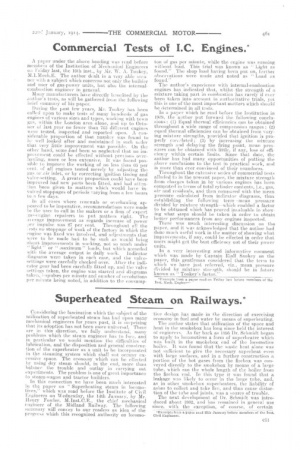Commercial Tests of I.C. Engines.*
Page 15

If you've noticed an error in this article please click here to report it so we can fix it.
A paper under the above heading was read before members of the Institution of Mechanical Engineers on Friday last, the 16th inst., by Mr. W. A. Tookey, M.I.Meeh.E. The author dealt in a very able teem ner with a subject which concerns not only the builder and user of gas-power units, but also the internalcombustion engineer in general. Many manufacturers have directly benefited by the author's tests, as will be gathered from the following brief summary of his paper.
Dining the past few years Mr. Tookey has been ealled upon to make tests of many hundreds of gas engines of various sizes and types, working with town gas, within the London area alone, and up to ()donee of last year no fewer than 763 different engines were tested, inspected and reported upon. A considerable proportion of that number was found to he well looked after and maintained in such ol der that, very little improvement was possible. On the other hand, acme had been so neglected that no improvement could be effected without previous oversending, more or less .extensive. It was found possible to improve the working of no less than 66 per cent. of all engines tested merely by adjusting the gas or air inlet, or by correcting ignition timing and valve-setting. A greater proportion could have been improved had new parts been fitted, and had attention been given to matters which would have involved stoppages of periods varying from a few hours to a few days.
In all eases where renewals Or overhauling appeared to be imperative, recommendations were made to time user to call in the makers or a firm of expert :sits-engine repairers to put matters right. The it erage improvement as regards increase of power
)er impulse was 27 per cent. Throughout all the vets no stoppage of work of the factory in which the engine was fixed was involved, and adjustments that were to be made had to be such as would bring about improvements in working, not so much under " light " or " maximum " loads, but which accorded with the average output in daily work. Indicator diagrams were taken in each case, and the valvesettings were carefully checked over. After the indicator gear had been carefully fitted up, and the valve settings taken, the engine was started .and diagrams taken, mpulses per minute and number of revolutions per minute being noted, in addition to the eonsump ton of gas per minute, while the engine was running without load. This trial was known as " Light as Sound.'' The shop load having been put on, further observations were made and noted as " Load as f ou The author's experience with internal-combustion engines has indicated that,. whilst the strength of a mixture taking part in combustion has rarely if ever been taken into account in authoritative trials, yet this is one of the roost important matters which should be determined in all tests.
In a panel which he read before the Institution in 1909, the author put forward the, following conclusions : (1) Equal thermal efficiencies can be obtained throughout a wide range of compression ranges ; (2) equal thermal efficiencies can be obtained from, varying mixture strengths, provided that ignition is properly correlated ; (3) by increasing the mixture strength and delaying the firing point, mean pressures -can be obtained with little, if any, loss of efficiency within certain limits. Since that date, the author has had many opportunities of putting the above conchiSions to the test in practical work, and is more than ever convinced of their soundness.
Throughout the extensive smies of commercial tests alluded to in the present paper, the mixture strength from charges taken in by various engines has been computed in terms of total cylinder contents, i.e., gas, air and residuals, and then compared with the mean pressure calculated from indicator diagrams, thus establishing the following terms-mean pressure divided by mixture strength—which. enabled a factor to be obtained which has proved invaluable in showing what steps should be taken in order to obtain better performances from arty engines inspected.
There was much interesting discussion On the paper, and it was acknowledged that the author had done ninth useful work in the matter of showing what improvements, if any, could be effected in order that users might get the best efficiency out of their power units.
In a very interesting .and informative comment which was made by Captain Mall Sankey on the paper, this gentleman considered that the term to which we have just referred, viz., mean pressure divided by mixture strength, should be in future known as " Tookey's factor."
4Excerpts from a paper read on Friday last before members of the Inst. Mech. Engine"'






















